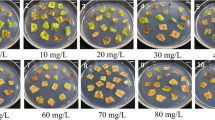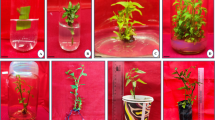Abstract
Selectable marker genes are widely used for the efficient transformation of crop plants. In most cases, selection is based on antibiotic or herbicide resistance genes because they tend to be most efficient. The Synechococcus hemL gene has been successfully employed as a selectable marker for tobacco and alfalfa genetic transformation, by using gabaculine as the selective agent. The gene conferring gabaculine resistance is a mutant form of the hemL gene from Synechococcus PCC6301, strain GR6, encoding a gabaculine insensitive form of the glutamate1-semialdehyde aminotransferase (GSA) enzyme. In the present study we compared the transformation and selection efficiency of the common selection method based on the Streptomyces hygroscopicus bar gene conferring resistance to Bialaphos®, with both the Synechococcus hemL gene and a Medicago sativa mutated GSA gene (MsGSAgr) conferring resistance to phytotoxin gabaculine. Callus derived from immature embryos of the durum wheat cultivar Varano were simultaneously co-bombarded with bar/hemL and bar/MsGSAgr genes. After gene delivery, the marker genes were individually evaluated through all the selection phases from callus regeneration to adult plant formation, and compared for their transformation and selection efficiency. The integration of the three genes in the T0 generation was confirmed by PCR analysis with specific primers for each gene and southern blot analysis. Both Synechococcus hemL and MsGSA were more efficient than bar for biolistic transformation (2.8% vs. 1.8% and 1.1% vs. 0.5%) and selection (79% vs. 43% and 87% vs. 50%). Thus, an efficient selection method for durum wheat transformation was established that obviates the use of herbicide resistance genes.




Similar content being viewed by others
References
Barro F, Cannel ME, Lazzeri PA, Barcelo P (1998) The influence of auxins on transformation of wheat and analysis of transgene integration patterns of transformants. Theor Appl Genet 97:684–695
Blechl AE, Anderson OD (1996) Expression of a novel high-molecular-weight glutenin subunit gene in transgenic wheat. Nat Biotechnol 14:875–879
Bliffeld M, Mundy J, Potrykus I, Futterer J (1999) Genetic engineering of wheat for increased resistance to powdery mildew disease. Theor Appl Genet 98:1079–1086
Christensen AH, Quail PH (1996) Ubiquitin promoter-based vectors for high-level expression of selectable and/or screenable marker genes in monocotyledonous plants. Transgenic Res 5:213–218
Dellaporta SL, Wood J, Hicks JB (1983) Isolation of DNA from higher plants. PMB Rep 4:19–21
Ferradini N, Nicolia A, Capomaccio S, Veronesi F, Rosellini D (2011) A point mutation in the Medicago sativa GSA gene provides a novel, efficient, selectable marker for plant genetic engineering. J Biotechnol 156:147–152
Gadaleta A, Blechl A, Nguyen S, Blanco A (2002) Embriogenic callus induction and plant regeneration variability among Italian durum wheat cultivars. In: Proceedings of EUCARPIA Cereal Section Meeting Salsomaggiore, Italy, pp 440–442
Gadaleta A, Giancaspro A, Blechl AE, Blanco A (2006) Phosphomannose isomerase, pmi, as a selectable marker gene for durum wheat transformation. J Cereal Sci 43:31–37
Gough KC, Haves WS, Kilpatrick J, Whitelam GC (2001) Cyanobacterial GR6 glutamate-1-semialdehyde aminotransferase: a novel enzyme-based selectable marker for plant transformation. Plant Cell Rep 20:296–300
Grimm B (1990) Primary structure of a key enzyme in plant tetrapyrrole synthesis: Glutamate 1-semialdehyde aminotransferase. PNAS 87:4169–4173
Grimm B, Kannangara CG, Smith AJ, Smith M (1991) Gabacline-resistant glutamate 1-semialdehyde aminotransferase of Synechococcus. J Biol Chem 19:12495–12501
He GY, Rooke L, Steele S, Bekes F, Gras P, Tatham AS, Fido R, Barcelo P, Shewry PR, Lazzeri PA (1999) Transformation of pasta wheat (Triticum turgidum L var durum) with high-molecular weight glutenin subunit genes and modification of dough functionality. Mol Breed 5:377–386
Hill CM, Pearson SA, Smith AJ, Rogers LJ (1985) Inhibition of chlorophyll synthesis in Hordeum vulgare by 3-amino-2,3-dihydrobenzoic acid (gabaculine). Biosci Rep 5:775–781
Houghton JD, Turner L, Brown SB (1988) Biosynthesis of ALA in Cyanidium caldarium: characterisation of tRNAglu, ligase, dehydrogenase and GSA. Carlsberg Res Commun 54:131–143
Kahn A, Kannangara CG (1987) Gabaculine-resistant mutants of chlamydomonas rheinhardtii with elevated glutamate 1-semialdehyde aminotransferase activity. Carlsberg Res Commun 52:73–81
Khan RS, Thirukkumaran G, Nakamura I, Mii M (2010) Rol (root loci) gene as a positive selection marker to produce marker-free Petunia hybrida. Plant Cell Tissue Organ Cult 101:279–285
Khan RS, Alam SS, Munir I, Azadi P, Nakamura I, Mii M (2011) Botrytis cinerea-resistant marker-free Petunia hybrida produced using the MAT vector system. Plant Cell Tissue Organ Cult 106:11–20
Kuiper HA, Kleter GA, Noteborn HP, Kok EJ (2001) Assessment of the food safety issues related to genetically modified foods. Plant J 27:503–528
Miki B, McHugh S (2004) Selectable marker genes in transgenic plants: applications, alternatives and biosafety. J Biotechnol 107:193–232
Ogawa T, Kawahigashi H, Toki S, Handa H (2008) Efficient transformation of wheat by using a mutated rice acetolactate synthase gene as a selectable marker. Plant Cell Rep 27:1325–1331
Ortiz JPA, Reggiardo MI, Ravizzini RA, Altabe SG, Cervigni GDL, Spitteler MA, Morata MM, Elias FE, Vallejos RH (1996) Hygromycin resistance as an efficient selectable marker for wheat stable transformation. Plant Cell Rep 15:877–881
Qiao G, Zhou J, Jiang J, Sun Y, Pan L, Song H, Jiang J, Zhuo R, Wang X, Sun Z (2010) Transformation of Liquidambar formosana L. via Agrobacterium tumefaciens using a mannose selection system and recovery of salt tolerant lines. Plant Cell Tissue Organ Cult 102:163–170
Ramessar K, Peremarti A, Gómez-Galera S, Naqvi S, Moralejo M, Muñoz P, Capell T, Christou P (2007) Biosafety and risk assessment framework for selectable marker genes in transgenic crop plants: a case of the science not supporting the politics. Transgenic Res 16:261–280
Rando RR (1977) Mechanism of the irreversible inhibition of γ-aminobutyric acid-α-ketoglutaric acid transaminase by the neurotoxin gabaculine. Biochemistry 16:4604–4610
Reinbothe S, Reinbothe C (1996) Regulation of chlorophyll biosynthesis in angiosperms. Plant Physiol 111:1–7
Rosellini D (2011) Selectable marker genes from plants: reliability and potential. In Vitro Cell Dev Biol-Pant 47:222–223
Rosellini D, Capomaccio S, Ferradini N, Savo Sardaro ML, Nicolia A, Veronesi F (2007) Non-antibiotic, efficient selection for alfalfa genetic engineering. Plant Cell Rep 26:1035–1044
Stoykova P, Stoeva-Popova P (2010) PMI (manA) as a nonantibiotic selectable marker gene in plant biotechnology. Plant Cell Tissue Organ Cult 105:141–148
Thiruvengadam M, Hsu WH, Yang CH (2011) Phosphomannose-isomerase as a selectable marker to recover transgenic orchid plants (Oncidium Gower Ramsey). Plant Cell Tissue Organ Cult 104:239–246
Weeks JT, Anderson OD, Blechl AE (1993) Rapid production of multiple independent lines of fertile transgenic wheat (Triticum aestivum). Plant Physiol 102:1077–1108
Witrzens B, Brettell RIS, Murray FR, McElroy D, Li Z, Dennis ES (1998) Comparison of three selectable marker genes for transformation of wheat by microprojectile bombardment. Aust J Plant Physiol 25:39–44
Acknowledgments
This work was supported by Ministero dell’Università e della Ricerca, project PRIN 2007 and Università degli Studi di Bari Aldo Moro, Italy, projects Ateneo 2007, 2008.
Author information
Authors and Affiliations
Corresponding author
Rights and permissions
About this article
Cite this article
Giancaspro, A., Rosellini, D., Blanco, A. et al. Gabaculine selection using bacterial and plant marker genes (GSA-AT) in durum wheat transformation. Plant Cell Tiss Organ Cult 109, 447–455 (2012). https://doi.org/10.1007/s11240-011-0109-2
Received:
Accepted:
Published:
Issue Date:
DOI: https://doi.org/10.1007/s11240-011-0109-2




